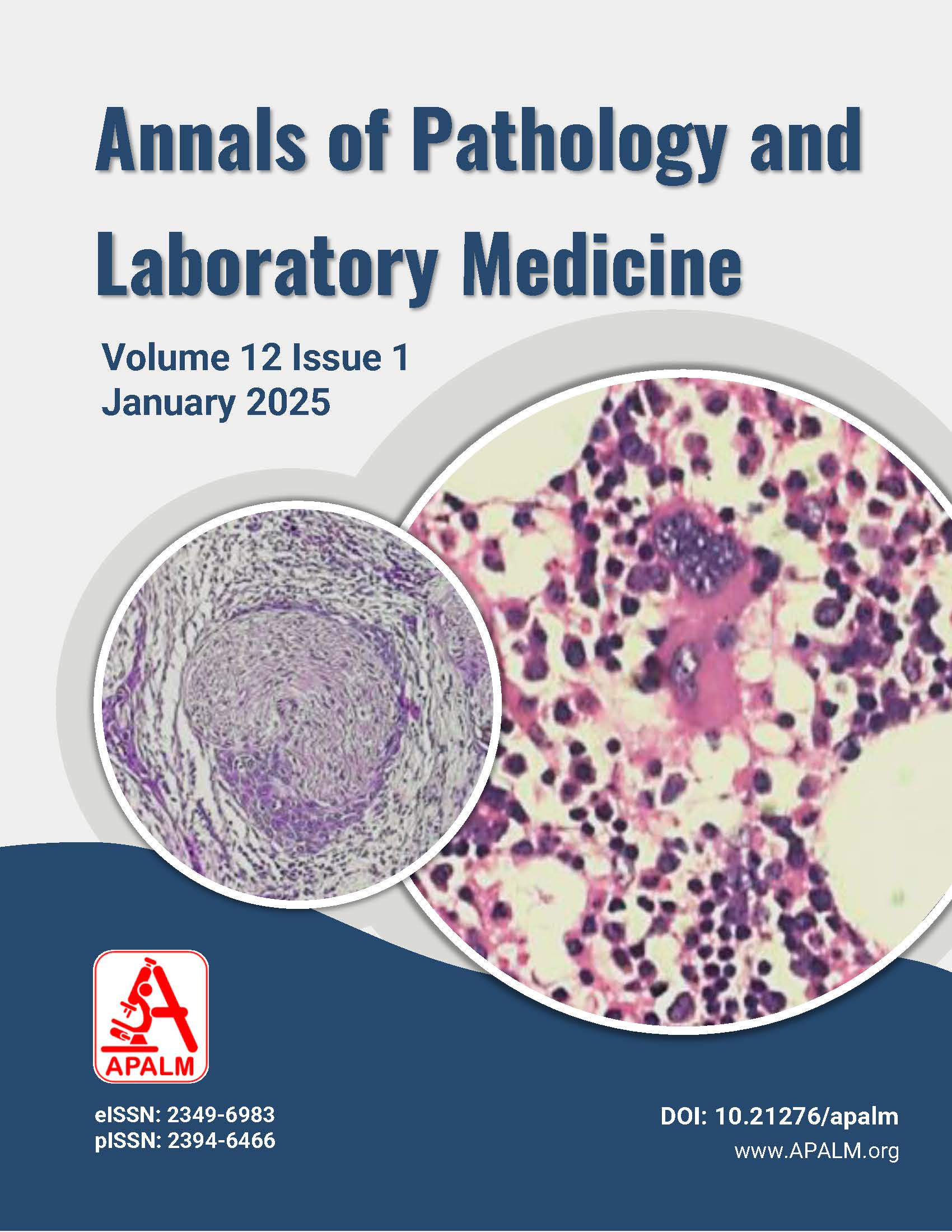Cystic Pleomorphic Adenoma: A Rare Occurrence and a Diagnostic Pitfall
DOI:
https://doi.org/10.21276/apalm.3460Keywords:
Pleomorphic adenoma, The Milan system, Salivary gland cyst, diagnostic dilemmaAbstract
Background: Cystic lesions of the salivary glands are a diagnostic dilemma. Pleomorphic adenoma, the most common neoplasm of the salivary gland, with cyst formation, is a rare event and can mimic various benign and malignant lesions.
Case report: Here, we report an interesting case of a 25-year-old male with cystic degeneration of pleomorphic adenoma.
Conclusion: Cyst formation in the salivary gland is not only seen in several cyst-associated lesions but can also be seen rarely in cyst-unassociated lesions like pleomorphic adenoma. Appropriate cytodiagnosis and optimal management of such cystic lesions require the application of the Milan System for Reporting Salivary Gland Cytopathology (MSRSGC).
References
1. Faquin WC, Powers CN. Cystic and mucinous lesions: mucocele and low-grade mucoepidermoid carcinoma. In: Faquin WC, Powers CN, editors. Salivary gland cytopathology. Boston, MA: Springer US; 2008. p. 159-81.
2. Allison DB, McCuiston AM, Kawamoto S, Eisele DW, Bishop JA, Maleki Z. Cystic major salivary gland lesions: utilizing fine needle aspiration to optimize the clinical management of a broad and diverse differential diagnosis. Diagn Cytopathol. 2017 Sep;45(9):800-7.
3. Schmidt RL, Hall BJ, Wilson AR, Layfield LJ. A systematic review and meta-analysis of the diagnostic accuracy of fine-needle aspiration cytology for parotid gland lesions. Am J Clin Pathol. 2011 Jul 1;136(1):45-59.
4. Salehi S, Maleki Z. Diagnostic challenges and problem cases in salivary gland cytology: a 20‐year experience. Cancer Cytopathol. 2018 Feb;126(2):101-11.
5. Faquin WC, Rossi ED, Baloch Z, Barkan GA, Foschini MP, Kurtycz DF, Pusztaszeri M, Vielh P, editors. The Milan system for reporting salivary gland cytopathology. Berlin, Germany: Springer International Publishing; 2018 Jan 31.
6. Eveson JW, Cawson RA. Salivary gland tumours. A review of 2410 cases with particular reference to histological types, site, age and sex distribution. J Pathol. 1985 May;146(1):51-8.
7. Xu B. Pleomorphic adenoma. PathologyOutlines.com website. Available from: https://www.pathologyoutlines.com/topic/salivaryglandspleomorphicadenoma.html. Accessed 2024 Jul 16.
8. Sudheendra US, Shashidara R, Chakki AB, Sreeshyla HS. Cystic pleomorphic adenoma of minor salivary glands. Int J Dent Clin. 2011 Apr 1;3(2):107-9.
9. Cibas ES, Ducatman BS. Cytology: diagnostic principles and clinical correlates. 5th ed. Kindle edition. Chapter 11, Salivary glands, diagnostic overview; p. 330-1.
10. Hang JF. Milan reporting system for salivary gland cytopathology. PathologyOutlines.com website. Available from: https://www.pathologyoutlines.com/topic/salivaryglandsmilandiagnostic.html. Accessed 2024 Jul 19.
11. Maleki Z, Allison DB, Butcher M, Kawamoto S, Eisele DW, Pantanowitz L. Application of the Milan System for Reporting Salivary Gland Cytopathology to cystic salivary gland lesions. Cancer Cytopathol. 2021 Mar;129(3):214-25.
12. Khetrapal S, Jetley S, Hassan MJ, Jairajpuri Z. Cystic change in pleomorphic adenoma: a rare finding and a diagnostic dilemma. J Clin Diagn Res. 2015 Nov;9(11):ED07.
Downloads
Published
Issue
Section
License
Copyright (c) 2025 Shujaat Khan, Parveen Choudhary, Priyanka Yadav, Nitesh Kumari Yadav, Shahnaz Parveen

This work is licensed under a Creative Commons Attribution 4.0 International License.
Authors who publish with this journal agree to the following terms:
- Authors retain copyright and grant the journal right of first publication with the work simultaneously licensed under a Creative Commons Attribution License that allows others to share the work with an acknowledgement of the work's authorship and initial publication in this journal.
- Authors are able to enter into separate, additional contractual arrangements for the non-exclusive distribution of the journal's published version of the work (e.g., post it to an institutional repository or publish it in a book), with an acknowledgement of its initial publication in this journal.
- Authors are permitted and encouraged to post their work online (e.g., in institutional repositories or on their website) prior to and during the submission process, as it can lead to productive exchanges, as well as earlier and greater citation of published work (See The Effect of Open Access at http://opcit.eprints.org/oacitation-biblio.html).










